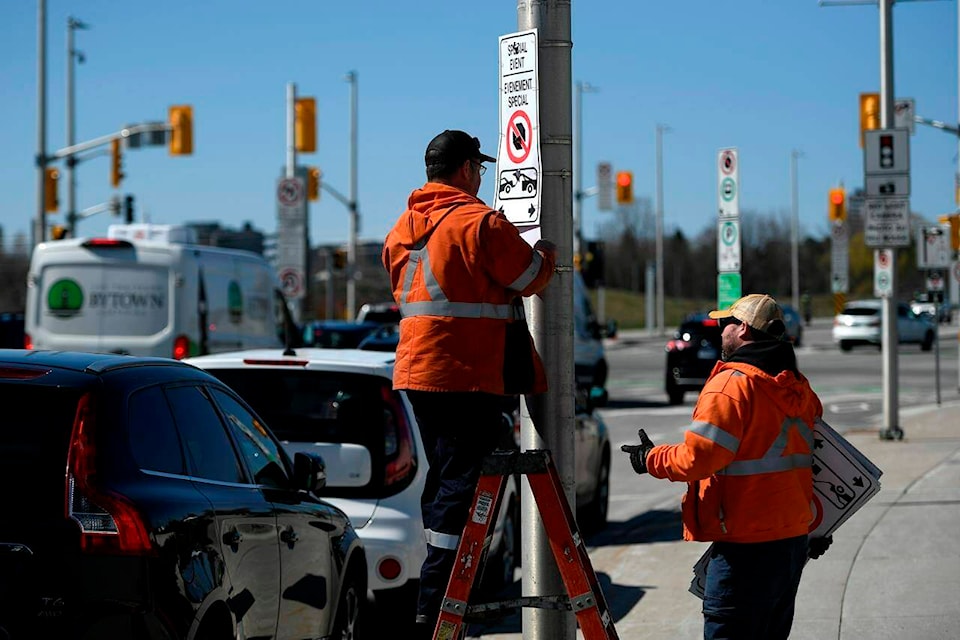OTTAWA — RCMP and police from across Ontario were stationed at major downtown intersections in the national capital Friday as “Rolling Thunder” protesters filed toward Parliament Hill.
The occasional rallying cry of “freedom!” from the crowd was reminiscent of those that echoed through Ottawa while the city was in the throes of what police have now called a three-week “illegal occupation.”
Ottawa has likely never been so prepared for a planned protest, with more than 800 backup officers ready to keep vehicles away from the areas where “Freedom Convoy” protesters entrenched themselves only months earlier.
Unlike in February, when protesters were allowed to pull their big-rig trucks right onto Wellington Street, the main drive in front of Parliament Hill, this time police have vowed no vehicles will be allowed as part of the protest.
Ottawa police said Friday several vehicle convoys were headed toward the capital in the hours before a planned rally on Parliament Hill, but that they would make every effort to divert them away.
The “Rolling Thunder” group has not been clear about the cause they’re rallying for, except to say they will “peacefully celebrate our freedom,” and they oppose the removal of veterans from the National War Memorial during the “Freedom Convoy.”
But the group does bear similarities to the previous protesters, and several participants on Friday said they attended the demonstration in February until police cleared them out.
The occupation prompted the federal government to invoke the Emergencies Act for the first time and ended after hundreds of police officers moved in to disperse the crowds, making dozens of arrests.
The rally Friday night is expected to be followed by a convoy of hundreds of motorcycles through downtown Saturday, with a stop at the War Memorial and another rally on Parliament Hill.
Vehicles won’t be allowed into a zone that includes the war monument and Parliament, police say, nor will they be allowed to stop along the route, but participants can walk through the area.
Angela Manella from North Bay, Ont., said she was in the national capital to protest the vaccine mandates in February, and she’s returned because the mandates are still in place.
“My experience of the convoy protest was that there was so much love and connection and just such good energy,” Manella said Friday next to the Centennial Flame.
“I want to continue that energy and that momentum to continue to stand up for all of us.”
She said there was a sense of community among protesters at the convoy in February, and that may be part of what is drawing people together again.
Others who gathered near the War Memorial said they are only in Ottawa this weekend to honour veterans who police removed from the site along with the rest of the protesters in February.
“It’s mostly like a parade to honour them for what they have done, they stood up for the right causes,” said a protester in a black leather vest who would only identify himself as Mario.
It’s also a chance for Ottawa’s police force to win back the trust and respect of the community, after coming under heavy criticism during the February protest for allowing it to go on so long before taking action.
For more than three weeks, protesters created encampments in downtown streets, which were packed with big rigs adorned with messages speaking out against vaccine mandates, COVID-19 restrictions and the prime minister.
While protesters described the scene as peaceful, joyful and even festival-like, nearby residents remember it as a nightmare — one they don’t want to relive.
“A lot of them are concerned, some are scared and some are mad,” said Mary Huang, president of the Centretown Community Association, which represents the neighbourhood closest to Parliament Hill.
She said neighbours are still traumatized after the protest. The loud airhorns droning on at all hours of the night meant that many couldn’t sleep, and some people felt intimidated when they left their homes, she said.
They’re worried this weekend will be a repeat, before residents have even had a chance to recover, she said.
Ottawa police have promised they won’t allow another “illegal occupation” of the city, that there will be no tolerance for a long-term protest and any encampments will be dismantled.
By 4 p.m. Friday, city bylaw officers said they had issued 185 tickets and towed 20 vehicles related to the rally.
A statement on the “Rolling Thunder” website attributed to organizer Neil Sheard says the protesters plan to leave on Sunday, and they do not support “blockades, obstruction of police performing their duties, damage to property or hate and vitriol directed to the residents of Ottawa.”
The statement also encourages supporters to follow the laws, and says police will be held accountable in court for their actions during the event.
“Lastly, as seen during the lawful protest in Ottawa, spread as much peace, love and patriotism to your fellow Canadians as possible,” the statement says.
Interim police chief Steve Bell said this week that people displaying symbols of hate, including swastikas, will be charged. A few such symbols were seen during the “Freedom Convoy” protest.
It is not explicitly illegal to display a swastika in Canada, but in a statement Ottawa police said it is a recognized symbol of hate, and it’s a criminal offence to incite hatred by displaying such imagery in public.
Prime Minister Justin Trudeau, asked Friday whether he would support an NDP bill to explicitly ban hate symbols, said his government would certainly work “across parties” to defend Canadians from harassment.
This report by The Canadian Press was first published April 29, 2022.
Laura Osman, Sarah Ritchie and Erika Ibrahim, The Canadian Press
